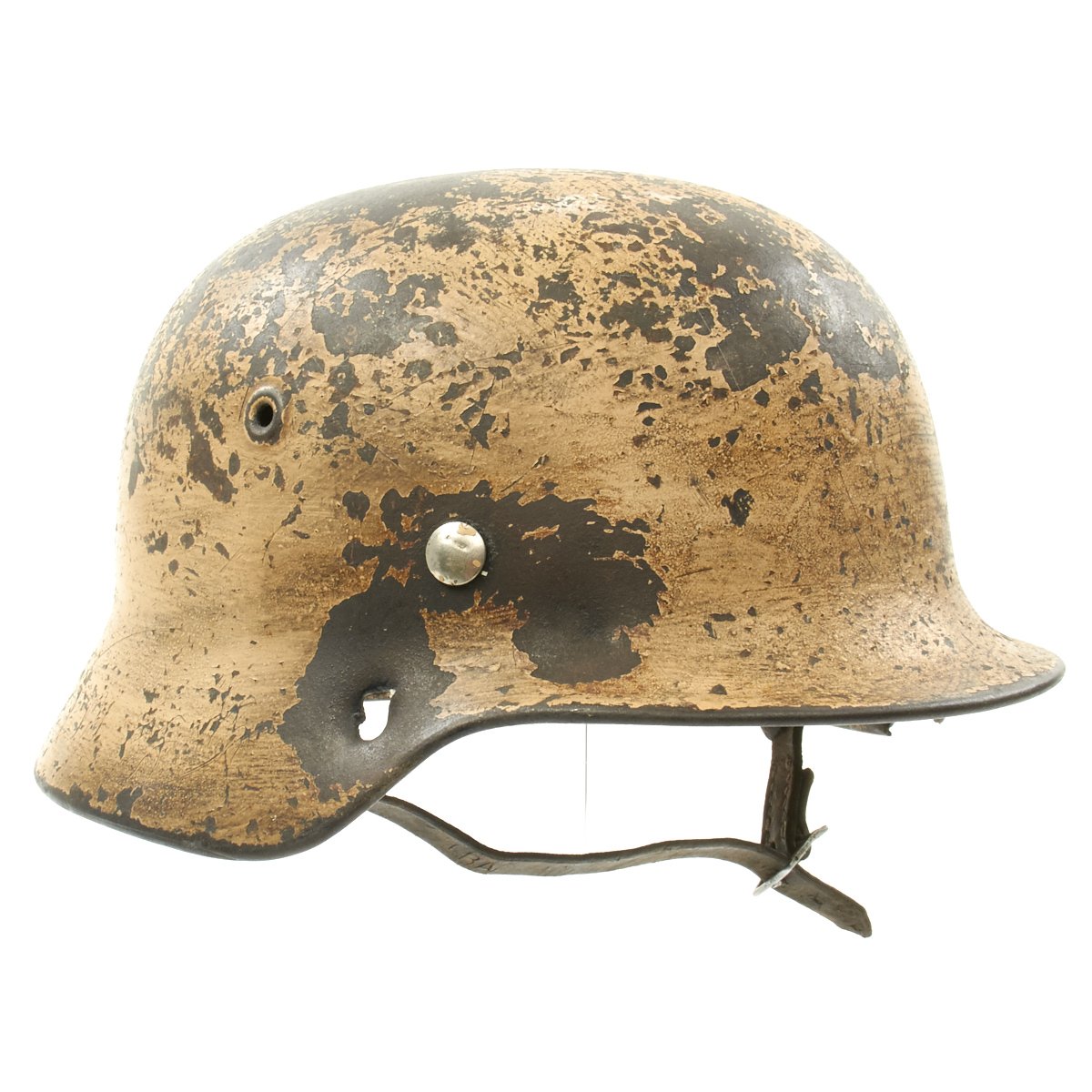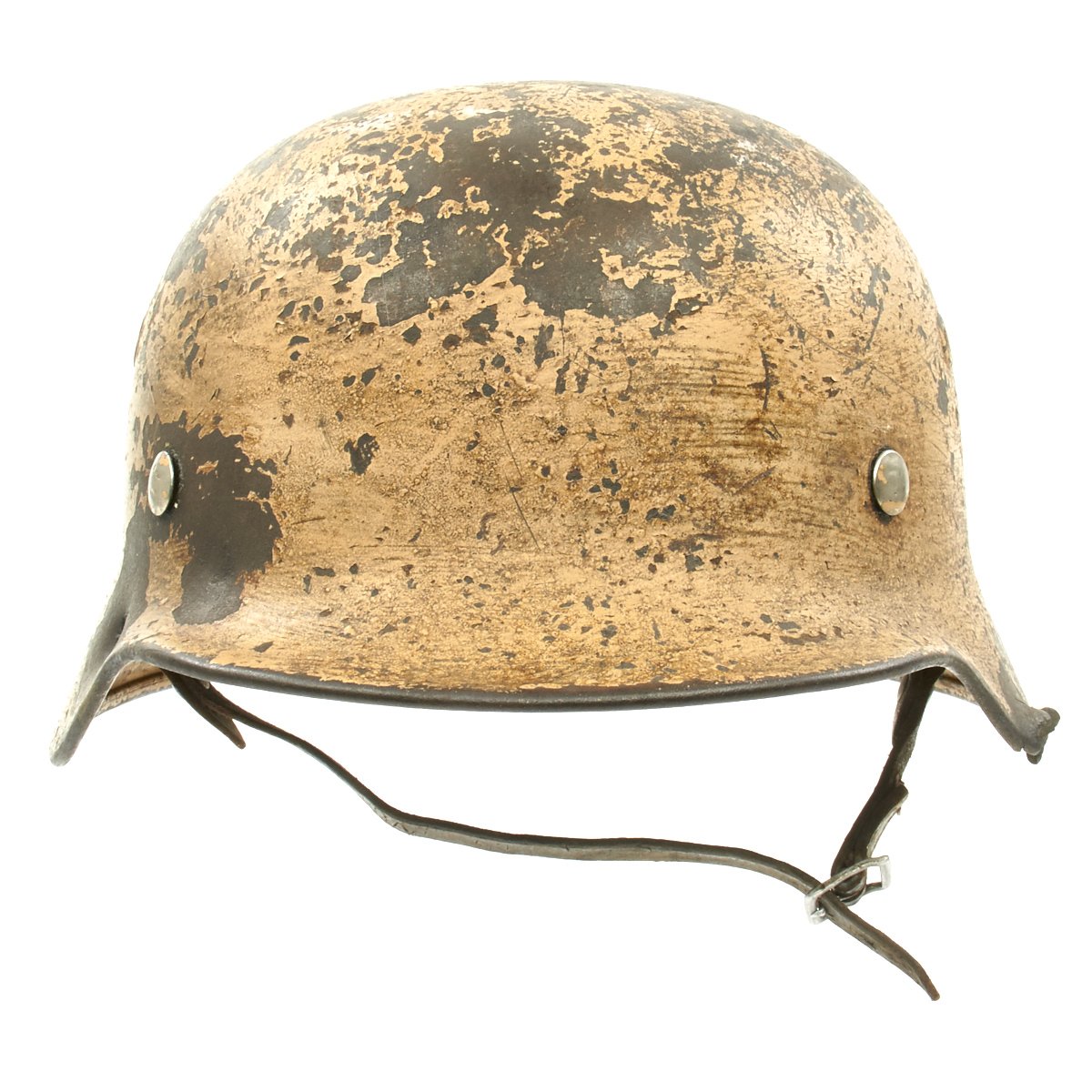Original German WWII M40 KIA Shot Through DAK Desert Dunkelgelb Tan Helmet – Marked ET66 Original Items
$ 1.995,00 $ 498,75
Original Item: Only One Available. This is an incredible all original example Model 1940 German WWII helmet, which was originally Field Gray (FeldGrau) but was overpainted with Deutsches Afrikakorps Desert Dunkelgelb (Dark Yellow) Tan for use in the North Africa campaign of WWII.
The unique aspects of this helmet are many; first there is a .30-06 caliber size bullet hole (Garand Rifle, 1903 Springfield, etc) that passes through the right side of the helmet and exits through the left. Close inspection of the paint, style and aging of the edges lead us to be very confident that this totally 100% genuine.
As with field repainted helmets, only the outside has had the Dunkelgelb applied, most likely with a brush, as indicated by the texture. It has some wear, but the overpaint is still over 70% complete, and the original Feldgrau paint can be seen where the paint is worn. All three liner retaining pins are intact.
The reverse, interior, neck guard apron is batch number stamped, 1848 and the interior, left side, apron has a stamped manufacturer’s code and size, ET66 indicating it was manufactured by Eisenhuttenwerk AG, Thale Harz. Size 66 is a nice large size that can accommodate liners from 58cm to 59cm or US 7 1/4 to 7 3/8. Size 66 shells are harder to find and are therefore more valuable to a collector.
The helmet still has its correct good condition M31 liner, with all of the fingers still intact. The leather itself is a very dark brown, due to long periods of wear, most likely in the desert heat. The galvanized steel liner band is marked 58, indicating a size 58 liner for a size 66 shell. The chinstrap is present, and in good condition with the end broken away.
Overall an incredibly rare shot through KIA 100% genuine German Afrikakorps helmet, ready to be a central talking point of any collection!
The first “modern” steel helmets were introduced by the French army in early 1915 and were shortly followed by the British army later that year. With plans on the drawing board, experimental helmets in the field, (“Gaede” helmet), and some captured French and British helmets the German army began tests for their own steel helmet at the Kummersdorf Proving Grounds in November, and in the field in December 1915. An acceptable pattern was developed and approved and production began at Eisen-und Hüttenwerke, AG Thale/Harz, (Iron and Foundry Works), in the spring of 1916.
These first modern M16 helmets evolved into the M18 helmets by the end of WWI. The M16 and M18 helmets remained in usage through-out the Weimar Reichswehr, (National Defence Force, Circa 1919-1933), era and on into the early years of the Third Reich until the development of the smaller, lighter M35 style helmet in June 1935.
The Luftwaffe pattern national eagle was originally introduced for wear by Fliegerschaft, (Pilot Base), personnel of the DLV, Deutscher Luftsportsverband, (German Air Sports Association), the clandestine, civilian, forerunner of the Luftwaffe on August 18TH 1934, and adopted for wear by the Luftwaffe on March 1ST 1935 along with the national tri-color shield for wear on the helmet.
The first pattern national eagle was utilized until a modified second pattern eagle was introduced in late 1936 or early 1937. Regulations of June 12TH 1940 discontinued the use of the national tri-color decal and further regulations of August 28TH 1943 abolished the national eagle decal and dictated that it was also to be removed from all helmets although the directives were not completely adhered to.
Fast Shipping with Professional Packaging
Thanks to our longstanding association with UPS FedEx DHL, and other major international carriers, we are able to provide a range of shipping options. Our warehouse staff is expertly trained and will wrap your products according to our exact and precise specifications. Prior to shipping, your goods will be thoroughly examined and securely secured. We ship to thousands clients each day across multiple countries. This shows how we're dedicated to be the largest retailer on the internet. Warehouses and distribution centres can be located throughout Europe as well as the USA.
Note: Orders with more than one item will be assigned a processing date depending on the item.
Before shipping before shipping, we'll conduct a thorough inspection of the items you have ordered. Today, the majority of orders will be delivered within 48 hours. The delivery time will be between 3-7 days.
Returns
The stock is dynamic and we cannot completely manage it because multiple stakeholders are involved, including our factory and warehouse. So the actual stock may alter at any time. It's possible that you may not receive your order once the order has been made.
Our policy is valid for a period of 30 days. If you don't receive the product within 30 days, we are not able to issue a refund or an exchange.
You can only return an item if it is unused and in the same state as the day you received it. You must have the item in its original packaging.
Related products
Uncategorized
Angolan Rebel 1970s era 60mm Inert Display Mortar from Angolan Civil War Original Items
Uncategorized
Uncategorized
Uncategorized
Uncategorized
Uncategorized
Uncategorized
Australian WWII Owen MK1 Machine Carbine SMG Custom Fabricated Replica with Sling Original Items
Uncategorized
Uncategorized
Uncategorized
Uncategorized
Armored Burgonet Helmet & Polearm from Scottish Castle Leith Hall Circa 1700 Original Items
Uncategorized
Uncategorized
Uncategorized
Band of Brothers ORIGINAL GERMAN WWII Le. F.H. 18 10.5cm ARTILLERY PIECE Original Items
Uncategorized
Armoured Fighting Vehicles of the World: AFVs of World War One (Hardcover Book) New Made Items
Uncategorized
Uncategorized
Uncategorized












































































